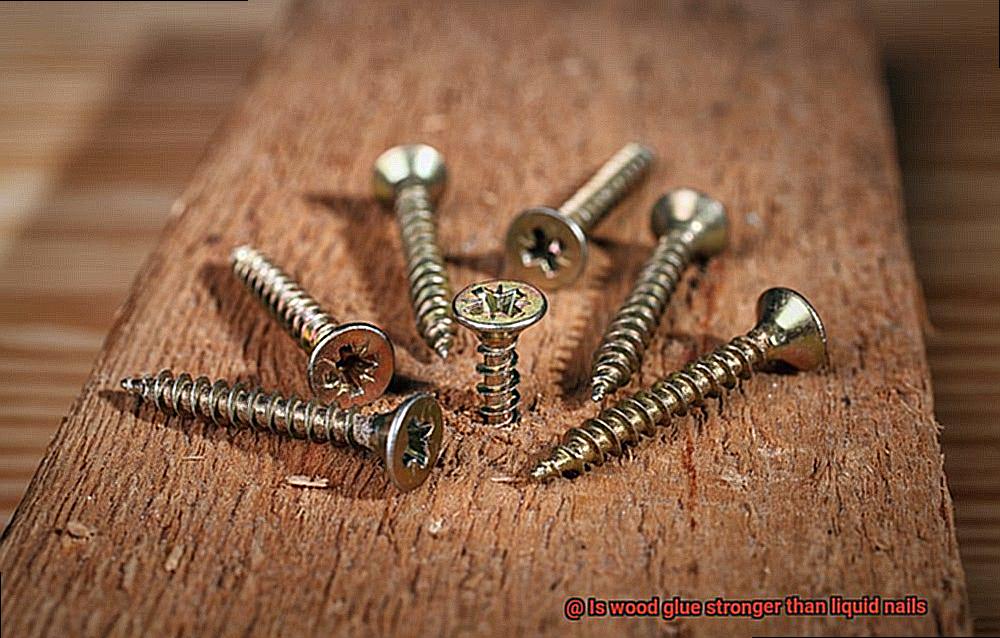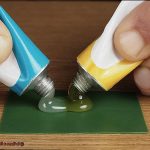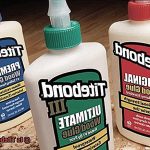When it comes to sticking wood together, there are two heavyweights in the ring: wood glue and liquid nails.
But which one packs the strongest punch? In this blog post, we’re going to get down and dirty with these adhesives, comparing their strength and durability.
We’ll dig into all the nitty-gritty details like how easy they are to apply, how long they take to dry, and if they play nice with different types of wood. By the time we’re done, you’ll know once and for all if wood glue or liquid nails is the ultimate champion when it comes to bonding wood.
So buckle up and get ready because we’re about to settle this sticky showdown.
What is Wood Glue?
Contents
Woodworking projects require strong and reliable bonds to ensure the durability and longevity of the final piece. Enter wood glue – a specialized adhesive designed to bond wood surfaces together. Wood glue offers exceptional strength, versatility, and gap-filling properties. In this article, we will delve into the fascinating world of wood glue, exploring its composition, types, and various applications.
Composition and Types:
Wood glue is crafted from natural or synthetic polymers combined with additives that enhance its adhesive properties. The most common type is polyvinyl acetate (PVA) glue, a water-based adhesive that dries clear. PVA glue is renowned for its robust bonding capabilities and versatility, making it suitable for a wide range of woodworking projects.
Another popular type is epoxy resin glue, which consists of a resin and a hardener. This adhesive creates an incredibly strong and durable bond, making it ideal for laminating or joining heavy wooden structures.
Applications:

Wood glue finds its applications in numerous woodworking projects. Here are some common uses:
- Joinery: From furniture to cabinetry, wood glue is essential for securely joining wooden pieces together. Its ability to penetrate porous wood fibers creates a bond stronger than the wood itself.
- Edge Banding: When applying thin strips of veneer or laminate to the edges of plywood or other materials, wood glue ensures a seamless and durable bond.
- Woodturning: Wood glue stabilizes cracks or fills voids in turned wooden objects like bowls or vases.
- Repairs: Broken furniture parts or damaged wooden structures can be effectively fixed with wood glue.
Tips for Optimal Bonding:
To achieve the best results with wood glue, follow these key tips:
- Surface Preparation: Ensure that the wood surfaces to be bonded are clean, dry, and free from dust or grease. Sanding the surfaces enhances bonding by creating a greater area for glue penetration.
- Clamping: Apply even pressure on the bonded surfaces using clamps or weights to maintain a tight bond while the glue dries. Follow the manufacturer’s instructions for recommended clamping time.
- Drying Time: Allow sufficient drying time for the glue to cure properly. Rushing this process may compromise the strength of the bond.
What is Liquid Nails?
When it comes to construction projects, a dependable adhesive is an absolute must-have. Enter Liquid Nails, the unrivaled powerhouse in the world of construction adhesives. Trusted by professionals and DIY enthusiasts alike, Liquid Nails is renowned for its unmatched strength and versatility.
No matter if you’re tackling a woodworking project, fixing concrete, or installing drywall, Liquid Nails has got your back. With its resilient and robust adhesive properties, it delivers a bond that stands the test of time. Wood, concrete, metal, plastics – Liquid Nails triumphs over them all.
One of the standout qualities of Liquid Nails is its remarkable versatility. It is equally at home indoors and outdoors, making it the ideal choice for any project you have in mind. Come rain or shine, this adhesive can withstand extreme temperatures, ensuring that your bond remains unyielding.
But wait, there’s more. Liquid Nails offers an array of formulations tailored to specific needs. Working with wood? There’s a formulation crafted exclusively for that material. Need that extra oomph in strength or flexibility? Liquid Nails has got your back with their specialized formulations designed to exceed expectations.

Applying Liquid Nails is an absolute breeze. Simply grab your trusty caulking gun and dispense the adhesive from the tube with ease. Smoothly and evenly apply it to the surfaces you want to unite. However, heed this crucial advice: proper surface preparation is key to achieving optimal adhesion. Ensure your surfaces are immaculate – clean, dry, and completely free from any dust, oil, or grease.
After application, give Liquid Nails some time to flex its muscles and reach its maximum strength. The precise curing time may vary depending on factors like temperature and humidity. To ensure dazzling results, always follow the manufacturer’s instructions down to the letter.
In conclusion, Liquid Nails reigns supreme as the ultimate construction adhesive. Its versatility, durability, and user-friendly nature make it the go-to choice for professionals and DIYers alike. So, whether you’re erecting, repairing, or crafting something extraordinary, rest assured that Liquid Nails will deliver the unbreakable bond you need.
Strength Comparison: Wood Glue vs Liquid Nails
When it comes to gluing wood, two heavy hitters in the adhesive game stand out: wood glue and Liquid Nails. These adhesives have gained popularity among woodworkers and DIY enthusiasts for their unique strengths. Let’s dive into a detailed comparison of these adhesive powerhouses to understand their capabilities better.
Wood glue, as the name suggests, is tailor-made for bonding wood surfaces together. Crafted from a blend of water, resin, and fillers, wood glue boasts an impressive strength that can withstand heavy loads. Its secret lies in its ability to penetrate the porous surface of the wood, forming a bond that often surpasses the strength of the wood itself. This quality makes it ideal for load-bearing joints and structural connections.
In contrast, Liquid Nails is a construction adhesive brand renowned for its versatility and strong initial grab. Capable of bonding a wide range of materials, including wood, metal, and concrete surfaces, Liquid Nails offers flexibility in various applications. Unlike wood glue, it doesn’t penetrate the surface of the wood but creates a robust bond by adhering to the surface. This feature enables Liquid Nails to hold materials in place even before complete curing.
Now, let’s talk about sheer strength. Wood glue generally outperforms Liquid Nails in this aspect. Rigorous testing has shown that wood glue exhibits higher resistance to shear forces compared to its counterpart. For those seeking bonds capable of withstanding heavy loads or stresses, wood glue is undoubtedly the go-to adhesive.
However, it is crucial to consider other factors that influence bond strength, such as surface preparation, application technique, and curing time. By following manufacturer instructions and ensuring proper surface preparation, both wood glue and Liquid Nails can achieve optimal bonding strength.
Factors Affecting Adhesive Strength
In the world of adhesives, two heavyweights reign supreme: wood glue and Liquid Nails. These formidable bonding agents possess unique strengths and find widespread use across various applications. But what factors truly shape their adhesive strength? Join us as we delve into the depths of glues and unravel the mysteries behind their bonding prowess.
Factor 1: The Mighty Adhesive Type
The type of adhesive employed plays a pivotal role in determining its strength. Wood glue, also known as PVA glue, exhibits a specialized affinity for bonding wood surfaces. Its water-based formulation seamlessly infiltrates the interwoven fibers of wood, forging an unyielding bond. In contrast, Liquid Nails stands as a versatile construction adhesive capable of bonding an extensive range of materials, including wood, metal, and concrete. Each adhesive possesses distinctive characteristics that contribute to its adhesive might.
Factor 2: The Art of Surface Preparation
The age-old adage “preparation is key” rings true when it comes to adhesive strength. Both wood glue and Liquid Nails demand pristine surfaces meticulously primed for optimal bonding. Any trace of dirt, dust, or contaminants lurking on these surfaces can impede adhesion and undermine the bond’s integrity. Thus, it becomes imperative to ensure surfaces are flawlessly smooth, dry, devoid of oil or grease, and diligently sanded or cleansed before applying the adhesive.
Factor 3: The Dance of Application Technique
The technique employed during adhesive application holds sway over its ultimate strength. For wood glue, a thin, even layer artfully spread across both surfaces guarantees maximum contact and fosters superior bonding. Conversely, Liquid Nails may require a more generous application to secure ample bond strength. Adhering to the manufacturer’s instructions regarding open time (the duration during which the adhesive remains malleable) and curing time (the period necessary for complete setting) becomes paramount to achieving optimal bond strength.
Factor 4: The Harmonious Substrate Compatibility
The compatibility between adhesive and substrate material emerges as a critical factor impacting adhesive strength. Wood glue, meticulously formulated for wood bonding, exhibits unparalleled adhesion to a plethora of wood types. Liquid Nails, on the other hand, flaunts its versatility by bonding an extensive array of materials. However, specific formulations of Liquid Nails may prove more amenable to certain materials compared to others, enhancing its prowess in diverse applications.
Factor 5: The Capricious Environmental Factors
Environmental conditions wield their influence over adhesive strength. Both wood glue and Liquid Nails require ample time to cure and set effectively. Extreme temperatures or high humidity levels elongate the curing process, while excessive airflow hastens drying, potentially compromising bond strength. Complying with the manufacturer’s guidelines concerning temperature and humidity ranges becomes paramount for optimal results.
Wood Glue: Pros and Cons
If you’re a woodworking enthusiast or simply curious about adhesives, you’re in the right place. Today, we’ll delve into the advantages and disadvantages of wood glue, providing you with all the information you need to make an informed decision for your next woodworking project.
Let’s start with the pros of wood glue. First and foremost, its strong bonding strength is a force to be reckoned with. When applied correctly, wood glue creates a bond that can withstand the stress and strain typically experienced by wood joints. This means your project will stand the test of time, even under heavy use.
Another advantage of wood glue is its relatively long open time. This gives you more flexibility and adjustment during the assembly process. No need to rush or panic if you need to make slight adjustments before everything sets in stone (or wood, in this case).
But wait, there’s more. Wood glue has another trick up its sleeve – it can fill gaps and cracks in the wood surface. This not only creates a seamless joint but also enhances the overall strength of the bond. Say goodbye to weak spots and hello to a sturdy, reliable connection.
Now let’s explore some of the not-so-great aspects of wood glue. One downside is that it requires clamping during the drying process. This can be time-consuming, especially for large or complex projects that require multiple clamps. However, this step is essential for achieving proper bonding, so it’s a small price to pay for a strong joint.
Additionally, wood glue has a longer curing time compared to other adhesives. It typically takes several hours to fully cure and achieve maximum bond strength. Patience is key when working with wood glue, my friends.
Furthermore, wood glue may not be suitable for non-porous materials like metal or plastic. It relies on the porosity of wood to form a strong bond, so keep that in mind when choosing your adhesive for different materials.
Lastly, over-application of wood glue can lead to excess squeeze-out. This can be messy and difficult to clean up, so be sure to apply the right amount of glue to avoid this sticky situation.
Liquid Nails: Pros and Cons
When it comes to glue, the options are endless. But when it comes to construction projects, one adhesive that stands out is Liquid Nails. This versatile adhesive has its fair share of pros and cons, so let’s dive into the details.

Pros:
- Strong bonding capability: Liquid Nails is a force to be reckoned with when it comes to creating a durable and long-lasting bond. It can seamlessly bring together materials like wood, metal, and concrete, making it an ideal choice for various construction projects.
- Versatility at its finest: Whether you’re working with porous or non-porous surfaces, Liquid Nails has got you covered. This adhesive can be used on a wide range of materials, from wood to tile to metal, making it an all-around superstar.
- Defying moisture: If your project is going to come into contact with water or high humidity levels, Liquid Nails is your go-to adhesive. Its resistance to moisture ensures that your bond remains strong even in damp environments.
- The need for speed: Time is of the essence in construction projects, and Liquid Nails delivers with its quick-drying formula. Say goodbye to long waiting periods as this adhesive sets in no time, allowing you to move forward with your project without delay.
- Options galore: Liquid Nails offers a variety of formulations to suit your specific needs. From heavy-duty to low VOC to specific formulas for different materials, you have the freedom to choose the perfect option for your project.
Cons:
- Tackiness trouble: One potential downside of using Liquid Nails is its initial stickiness. When first applied, this adhesive can be quite tacky, requiring extra care and precision during installation.
- A scent that lingers: Some users have reported a strong odor when using Liquid Nails, which can be unpleasant. Proper ventilation during application is necessary to combat this issue.
- Structural limitations: While Liquid Nails boasts excellent bonding strength, it is not recommended for structural applications or load-bearing projects. For such scenarios, wood glue would be a better choice due to its superior structural capabilities.
- A heavier price tag: Compared to traditional wood glue options, Liquid Nails may come with a slightly higher cost. However, the added benefits and versatility it offers often justify the investment for many users.

Choosing the Right Adhesive for Your Project
Adhesives are the unsung heroes of DIY projects, silently holding our creations together and ensuring their durability. But with a vast array of options available, how do you select the perfect adhesive for your project? Fear not. As an adhesive expert, I am here to guide you through the selection process.
First and foremost, consider the type of materials you will be bonding. Different adhesives are tailored for specific materials, such as wood, metal, plastic, or fabric. It is crucial to choose an adhesive that is compatible with the materials you are working with; otherwise, your project may crumble before your eyes.
Next, determine the strength of the bond required. Are you seeking a permanent bond or a temporary one? For woodworking projects, wood glue reigns supreme. It creates a bond that is often stronger than the wood itself, guaranteeing stability and longevity. On the other hand, if versatility across various materials is essential, liquid nails is a go-to construction adhesive. While it may not match the sheer strength of wood glue, it offers reliable bonding capabilities across different material types.
Time is of the essence. Consider the drying time of the adhesive. If you are working on a time-sensitive project or require immediate bonding, opt for wood glue as it dries faster than liquid nails. However, if patience is your virtue, liquid nails will eventually dry and fully cure.
Ease of use should not be overlooked either. Wood glue typically comes in a bottle with an applicator tip, allowing for direct application onto surfaces. Liquid nails are often packaged in caulk tubes or squeeze bottles and may require a caulk gun for application. Choose an adhesive that aligns with your preferred application method to ensure convenience and efficiency.
Lastly, factor in cost and availability. Wood glue is widely accessible and relatively affordable, making it a favorite among DIYers. Liquid nails may carry a slightly higher price tag but offers the flexibility to bond different materials.
U47qRNLDgqU” >
Also Read: Will liquid nails adhere wood to concrete? – Glue Things
Conclusion
In the epic clash between wood glue and Liquid Nails, these adhesives reveal their unique strengths and weaknesses. Wood glue stands tall with its unrivaled bonding capabilities and gap-filling prowess, making it a trusted companion for woodworking ventures. Its sheer strength triumphs over Liquid Nails in handling shear forces, making it the go-to choice for load-bearing joints and structural connections.
But hold on tight, because Liquid Nails isn’t backing down without a fight. This versatile construction adhesive flaunts its ability to bond an array of materials – wood, metal, concrete – you name it. With its impressive initial grab and resistance to moisture, Liquid Nails proves itself worthy of indoor and outdoor applications alike. While it may not outmuscle wood glue in terms of raw strength, Liquid Nails showcases reliable bonding capabilities across different material types.
When faced with the decision between these two adhesive powerhouses, take into account the materials at hand, the desired bond strength, drying time, ease of use, and cost. Wood glue takes the lead in availability and affordability compared to Liquid Nails.
Ultimately, your choice between wood glue and Liquid Nails hinges on your project’s specific needs. Both contenders boast undeniable merits and have the potential to forge unbreakable bonds when handled with finesse.






